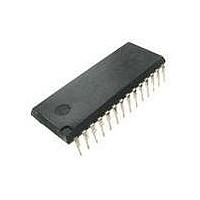MC9S08RD32PE Freescale Semiconductor, MC9S08RD32PE Datasheet - Page 161

MC9S08RD32PE
Manufacturer Part Number
MC9S08RD32PE
Description
IC MCU 32K FLASH 2K RAM 28-DIP
Manufacturer
Freescale Semiconductor
Series
HCS08r
Datasheet
1.MC9S08RE8FJE.pdf
(234 pages)
Specifications of MC9S08RD32PE
Core Processor
HCS08
Core Size
8-Bit
Speed
8MHz
Connectivity
SCI
Peripherals
LVD, POR, PWM, WDT
Number Of I /o
23
Program Memory Size
32KB (32K x 8)
Program Memory Type
FLASH
Ram Size
2K x 8
Voltage - Supply (vcc/vdd)
1.8 V ~ 3.6 V
Oscillator Type
Internal
Operating Temperature
0°C ~ 70°C
Package / Case
28-DIP (0.600", 15.24mm)
Processor Series
S08RD
Core
HCS08
Data Bus Width
8 bit
Data Ram Size
2 KB
Interface Type
SCI
Maximum Clock Frequency
8 MHz
Number Of Programmable I/os
39
Number Of Timers
2
Operating Supply Voltage
1.8 V to 3.6 V
Maximum Operating Temperature
+ 70 C
Mounting Style
Through Hole
3rd Party Development Tools
EWS08
Development Tools By Supplier
DEMO9S08RG60E
Minimum Operating Temperature
0 C
Lead Free Status / RoHS Status
Lead free / RoHS Compliant
Eeprom Size
-
Data Converters
-
Lead Free Status / Rohs Status
Lead free / RoHS Compliant
Available stocks
Company
Part Number
Manufacturer
Quantity
Price
Company:
Part Number:
MC9S08RD32PE
Manufacturer:
Freescale Semiconductor
Quantity:
135
- Current page: 161 of 234
- Download datasheet (2Mb)
SCI1D. After IDLE has been cleared, it cannot become set again until the receiver has received at least one
new character and has set RDRF.
If the associated error was detected in the received character that caused RDRF to be set, the error flags —
noise flag (NF), framing error (FE), and parity error flag (PF) — get set at the same time as RDRF. These
flags are not set in overrun cases.
If RDRF was already set when a new character is ready to be transferred from the receive shifter to the
receive data buffer, the overrun (OR) flag gets set instead and the data and any associated NF, FE, or PF
condition is lost.
12.3.5
The following sections describe additional SCI functions.
12.3.5.1
The SCI system (transmitter and receiver) can be configured to operate in 9-bit data mode by setting the
M control bit in SCI1C1. In 9-bit mode, there is a ninth data bit to the left of the MSB of the SCI data
register. For the transmit data buffer, this bit is stored in T8 in SCI1C3. For the receiver, the ninth bit is
held in R8 in SCI1C3.
For coherent writes to the transmit data buffer, write to the T8 bit before writing to SCI1D.
If the bit value to be transmitted as the ninth bit of a new character is the same as for the previous character,
it is not necessary to write to T8 again. When data is transferred from the transmit data buffer to the
transmit shifter, the value in T8 is copied at the same time data is transferred from SCI1D to the shifter.
9-bit data mode typically is used in conjunction with parity to allow eight bits of data plus the parity in the
ninth bit. Or it is used with address-mark wakeup so the ninth data bit can serve as the wakeup bit. In
custom protocols, the ninth bit can also serve as a software-controlled marker.
12.3.5.2
During all stop modes, clocks to the SCI module are halted.
In stop1 and stop2 modes, all SCI register data is lost and must be re-initialized upon recovery from these
two stop modes.
No SCI module registers are affected in stop3 mode.
Because the clocks are halted, the SCI module will resume operation upon exit from stop (only in stop3
mode). Software should ensure stop mode is not entered while there is a character being transmitted out of
or received into the SCI module.
12.3.5.3
When LOOPS = 1, the RSRC bit in the same register chooses between loop mode (RSRC = 0) or
single-wire mode (RSRC = 1). Loop mode is sometimes used to check software, independent of
connections in the external system, to help isolate system problems. In this mode, the transmitter output is
Freescale Semiconductor
Additional SCI Functions
8- and 9-Bit Data Modes
Stop Mode Operation
Loop Mode
MC9S08RC/RD/RE/RG Data Sheet, Rev. 1.11
Serial Communications Interface (S08SCIV1)
161
Related parts for MC9S08RD32PE
Image
Part Number
Description
Manufacturer
Datasheet
Request
R
Part Number:
Description:
Manufacturer:
Freescale Semiconductor, Inc
Datasheet:
Part Number:
Description:
Manufacturer:
Freescale Semiconductor, Inc
Datasheet:
Part Number:
Description:
Manufacturer:
Freescale Semiconductor, Inc
Datasheet:
Part Number:
Description:
Manufacturer:
Freescale Semiconductor, Inc
Datasheet:
Part Number:
Description:
Manufacturer:
Freescale Semiconductor, Inc
Datasheet:
Part Number:
Description:
Manufacturer:
Freescale Semiconductor, Inc
Datasheet:
Part Number:
Description:
Manufacturer:
Freescale Semiconductor, Inc
Datasheet:
Part Number:
Description:
Manufacturer:
Freescale Semiconductor, Inc
Datasheet:
Part Number:
Description:
Manufacturer:
Freescale Semiconductor, Inc
Datasheet:
Part Number:
Description:
Manufacturer:
Freescale Semiconductor, Inc
Datasheet:
Part Number:
Description:
Manufacturer:
Freescale Semiconductor, Inc
Datasheet:
Part Number:
Description:
Manufacturer:
Freescale Semiconductor, Inc
Datasheet:
Part Number:
Description:
Manufacturer:
Freescale Semiconductor, Inc
Datasheet:
Part Number:
Description:
Manufacturer:
Freescale Semiconductor, Inc
Datasheet:
Part Number:
Description:
Manufacturer:
Freescale Semiconductor, Inc
Datasheet:











